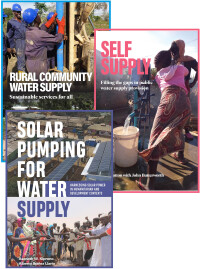Water, Sanitation and Hygiene
-
Gardening in with Grey and Rain water in refugee camps
Rita Khawand, Shaher Abdulateef, Richard Luff
An illustrated guide: How to save and use grey water and rain water for food growing in refugee camps and settlements. Made in partnership with SOILS Permaculture Association - Lebanon, and Malteser International. Re-Alliance is a coalition of field practitioners, policymakers, educators, community...
-
Sanitation in Humanitarian Settings
In an emergency the collection, treatment and disposal/reuse of human waste is critical to the health, wellbeing and environment of affected populations. Addressing this is difficult and complex requiring an understanding of the technical, social, institutional, political and environmental issues af...
-
Addressing Conflict, COVID, and Climate Change
Marielle Snel, Nikolas Sorensen
Humanitarian crises are growing in length and complexity due to external destabilising pressures including conflict, COVID, and climate change, with the average length of refugee situations now exceeding twenty years. Until now, there has not been any specific WASH publication of this kind that refl...
-
Tratamento de lodo fecal e esgoto séptico
Muitos países de média e baixa renda estão passando por um processo de urbanização rápida, que gera a necessidade de melhores serviços, incluindo o de saneamento. Enquanto algumas áreas no espaço urbano têm serviços de saneamento, a maioria das pessoas, especialmente a população de baixa renda, cont...
-
Gestion de nos dechets 2021
La gestion des déchets que nous produisons tous constitue un défi grandissant dans le monde entier. Les problèmes de gestion des déchets sont habituellement décrits et mesurés en termes de flux de matières et d’incidences environnementales. Cependant, il s’agit d’un problème humain ayant d’important...
-
Le pompage solaire pour l’approvisionnement en eau
Alberto Ibáñez Llario, Asenath W. Kiprono
L’énergie solaire pour le pompage d’eau souterraine renferme un énorme potentiel d’accroissement de la durabilité des systèmes d’approvisionnement en eau. Cependant, le manque de connaissances, de capacité et d’expertise en matière de conception et de mise en oeuvre de ces systèmes ralentit leur ado...
-
Managing Our Waste 2021
Dealing with the waste we all generate is a growing global challenge. Waste management problems are conventionally described and measured in terms of material flows and environmental impacts, yet this is a human problem with major social, health, and economic impacts, felt most acutely by some of th...
-
Bridging the WASH Humanitarian–development Divide
Marielle Snel, Nikolas Sorensen
The provision of safe and sufficient water, sanitation, and hygiene (WASH) services is essential to protecting human health and providing an environment in which people can develop and maintain livelihoods. This is especially true in humanitarian crises, during which safe access to these services is...
-
Rural Water Supply Set
The first Water Decade aimed to serve everyone with safe drinking water by 1990. More than three decades later, the task is far from finished; it is now abundantly clear that it will take more time — in some countries much more time — than the 15 years of the Sustainable Development Goals. Despit...
-
Rural Community Water Supply
The first Water Decade aimed to serve everyone with safe drinking water by 1990. More than three decades later, the task is far from finished; it is now abundantly clear that it will take more time — in some countries much more time — than the 15 years of the Sustainable Development Goals. Despite t...










